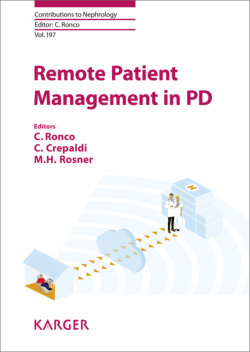Читать книгу Remote Patient Management in Peritoneal Dialysis - Группа авторов - Страница 7
На сайте Литреса книга снята с продажи.
Preface
ОглавлениеTelemedicine (TM) and remote patient management (RPM) are innovative tools for providing remote transmission, interpretation and storage of clinical parameters, physiological variables or images/videos which can be sent to a central monitoring center for review and intervention of the care team. These tools allow for accurate home monitoring of patients, enabling the team to improve care through prevention and early identification of problems, with consequent timely interventions. TM and RPM have been proven to be useful in chronic diseases such as heart failure, diabetes, and hypertension. Some of the goals of TM and RPM are to allow patients to maintain their normal life activities, preventing complications and minimizing costs. In the dialysis setting, TM and RPM have been sporadically utilized, and single-center reports have demonstrated patient satisfaction and effective utility with the provision of timely interventions. Technological innovations in this area are occurring at a rapid rate and clinicians are increasingly turning to TM and RPM as solutions for improving care and outcomes. The care of patients on peritoneal dialysis is an ideal model for using TM and RPM, and this volume highlights these opportunities.
Recently, a novel automated cycler for peritoneal dialysis, connected with a modem to a cloud-based network, has been introduced in clinical practice (HOMECHOICE CLARIATM, Baxter Healthcare, Deerfield, IL, USA). This equipment has a built-in remote treatment monitoring capability, with the ability to receive and transmit data through a TM platform from and to a PD center. RPM with this platform offers the potential benefits of accurate monitoring of therapy, improved patient safety through surveillance of critical stages of treatment, early detection of problems or non-compliance to prescription.
The book is structured into 4 main parts. The first describes the evolution of peritoneal dialysis and related technology. The second part summarizes the current unmet clinical needs reported by patients and care team, the need for innovation in this field, the technical and clinical issues involved with the modern management of peritoneal dialysis. The third part presents the operational characteristics of the new information communication technology system and in detail, the features of the Sharesource platform. Finally, a series of field experiences by expert users are reported that describe the benefits and the potential applications of RPM in the future.
The ultimate scope of the book, therefore, is to collect the experience of clinical key opinion leaders who had been involved in the application of this remote management system and have been instrumental in the application and evolution of some aspects of the system.
Carlo Crepaldi
Mitchell H. Rosner
Claudio Ronco
